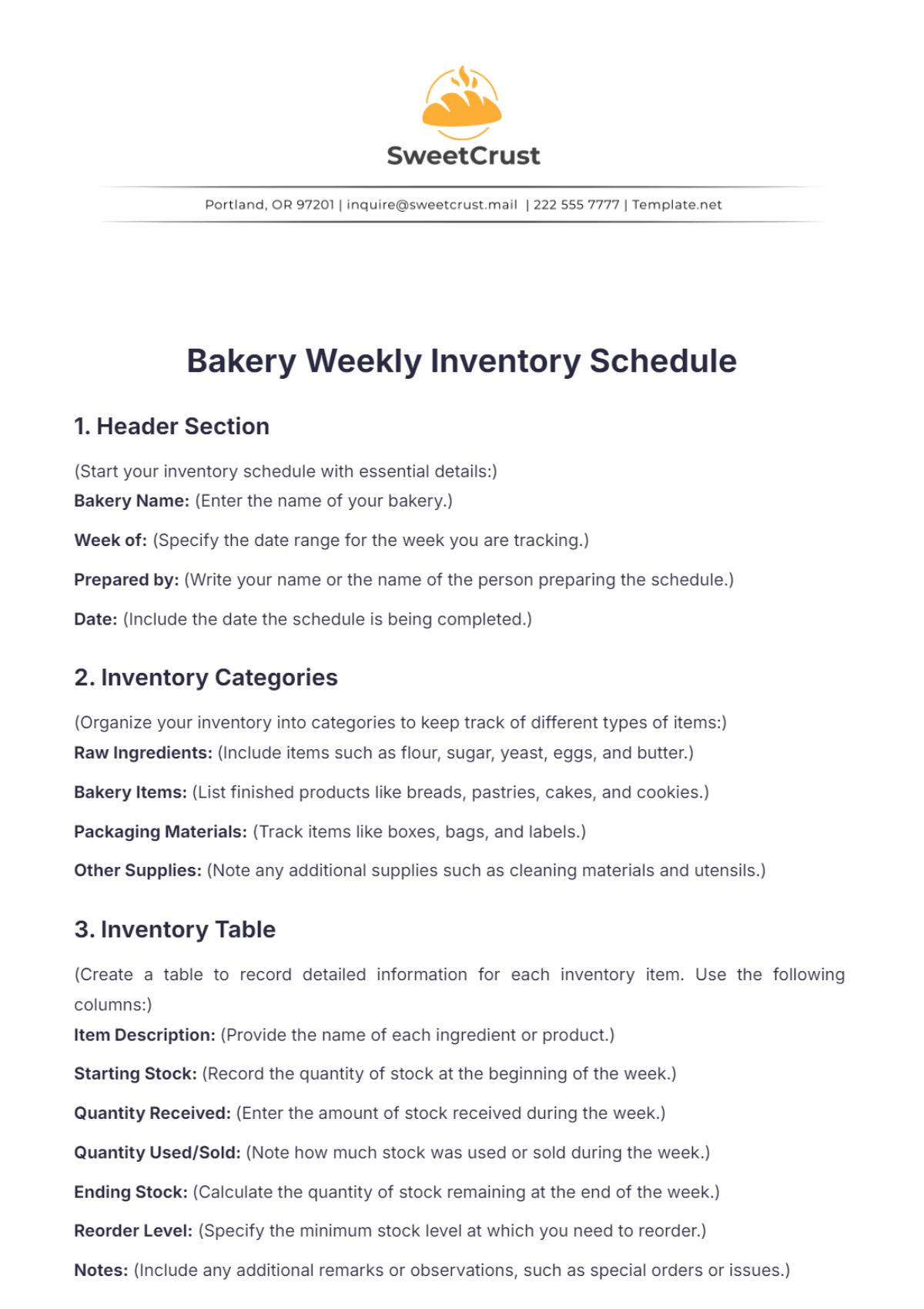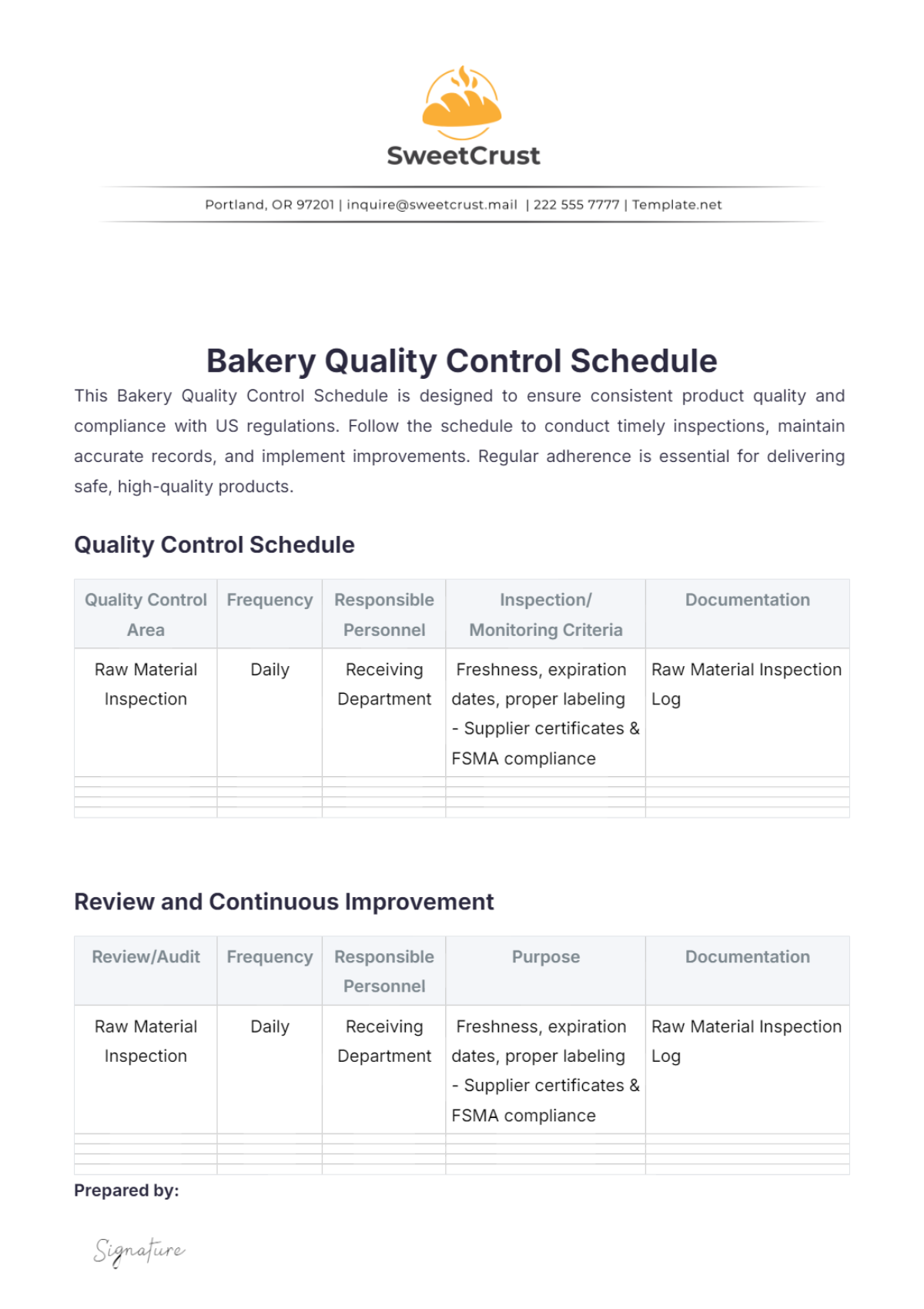Bakery Waste Management SOP Sample
I. Introduction
A. Purpose
Define Waste Management Goals: The purpose of this Bakery Waste Management SOP is to establish a comprehensive framework for managing waste generated by [Your Company Name]. This SOP aims to ensure compliance with environmental regulations and promote sustainable practices in waste management.
Environmental Responsibility: Effective waste management is crucial to minimize the environmental impact of bakery operations. By implementing these guidelines, [Your Company Name] aims to reduce waste, increase recycling efforts, and lower our carbon footprint.
Operational Efficiency: Efficient waste management practices contribute to the overall operational efficiency of the bakery. By optimizing waste disposal and recycling processes, we can reduce costs and improve workplace safety.
B. Scope
Application to All Staff: This SOP applies to all employees involved in the production, packaging, and disposal processes at [Your Company Name]. Compliance with these procedures is mandatory to ensure effective waste management.
Inclusion of All Waste Types: The scope of this SOP includes all types of waste generated by the bakery, including organic waste, packaging materials, and non-recyclable waste. Each category requires specific handling and disposal methods to minimize environmental impact.
Review and Updates: This SOP will be reviewed regularly to incorporate new waste management practices and ensure ongoing compliance with environmental regulations. Updates will be communicated to all staff as necessary.
C. Definitions
Organic Waste: Organic waste refers to biodegradable waste materials, such as food scraps, bakery by-products, and expired ingredients. This type of waste requires specific disposal methods to prevent contamination and promote composting.
Non-Recyclable Waste: Non-recyclable waste includes materials that cannot be processed through standard recycling channels, such as certain plastics and contaminated packaging. These materials must be disposed of in designated waste bins.
Recyclable Materials: Recyclable materials include paper, cardboard, glass, and certain plastics. These materials can be reprocessed into new products, reducing the need for raw materials and minimizing landfill waste.
II. Waste Segregation
A. Segregation Guidelines
Organic Waste: Organic waste should be collected separately from other waste types to facilitate composting or anaerobic digestion. This process helps reduce landfill waste and produces valuable compost for agricultural use.
Recyclable Materials: Recyclable materials, such as paper and plastics, must be sorted into designated recycling bins. Clear labeling and signage will assist staff in correctly identifying and disposing of recyclable items.
Non-Recyclable Waste: Non-recyclable waste should be placed in general waste bins for landfill disposal. Regular monitoring of these bins ensures that only appropriate materials are disposed of as non-recyclable waste.
Hazardous Waste: Hazardous waste, such as cleaning chemicals and expired products, requires specialized disposal according to environmental regulations. Staff must be trained in the safe handling and disposal of hazardous materials.
Regular Monitoring: Regular monitoring of waste segregation practices ensures compliance with the SOP and identifies areas for improvement. Staff feedback and observations will be used to enhance waste segregation procedures.
Proper segregation is essential to minimize contamination and ensure the efficiency of recycling and disposal processes. By maintaining clear guidelines and conducting regular audits, [Your Company Name] can reduce waste management costs and enhance its environmental impact.
B. Segregation Practices
Color-Coded Bins: Use color-coded bins to help staff easily identify and sort different waste types. This system simplifies the segregation process and reduces the likelihood of contamination.
Signage and Labels: Clear signage and labels on waste bins provide instructions on the correct disposal method for each waste type. This visual aid ensures consistent and accurate waste segregation.
Training Programs: Conduct regular training programs to educate staff on waste segregation practices. Training should cover the importance of waste reduction, recycling techniques, and proper disposal methods.
Audits and Feedback: Implement regular waste audits to assess the effectiveness of segregation practices. Staff feedback and observations will be used to identify challenges and implement improvements.
Collaboration with Partners: Collaborate with waste management partners to ensure efficient waste collection and processing. Regular communication with partners can help optimize waste disposal and recycling operations.
Effective waste segregation practices are essential for reducing landfill waste and promoting sustainability. By educating staff and implementing robust procedures, [Your Company Name] can enhance its environmental stewardship and operational efficiency.
III. Waste Collection
A. Collection Schedule
The following table outlines the waste collection schedule for different waste types. Regular collection ensures that waste is managed efficiently and prevents the accumulation of waste on-site.
Waste Type | Collection Frequency |
|---|---|
Organic Waste | Daily |
Recyclable Materials | Twice a week |
Non-Recyclable Waste | Weekly |
Hazardous Waste | As needed |
Organic Waste Collection: Organic waste should be collected daily to prevent odors and pests. Regular collection ensures that organic waste is processed promptly and minimizes environmental impact.
Recyclable Materials Collection: Recyclable materials, such as paper and plastics, should be collected twice a week. This frequency ensures that recyclable materials are processed efficiently and reduces the risk of contamination.
Non-Recyclable Waste Collection: Non-recyclable waste should be collected weekly to maintain cleanliness and prevent waste buildup. This schedule allows for efficient disposal of waste that cannot be recycled.
Hazardous Waste Collection: Hazardous waste requires specialized collection and disposal. Collection should occur as needed, following all regulatory requirements to ensure safe handling and disposal.
Regular waste collection is crucial to maintaining a clean and safe working environment. By adhering to the collection schedule, [Your Company Name] can ensure that waste is managed effectively and minimize its environmental footprint.
B. Waste Collection Procedures
Collection Point Setup: Establish designated collection points for each waste type to streamline the collection process. Clear signage and easy access to collection points facilitate efficient waste disposal.
Waste Transport: Transport waste to collection points using appropriate equipment and containers. Ensure that waste is contained securely to prevent spills and contamination during transportation.
Safety Precautions: Implement safety precautions during waste collection to protect staff and minimize risks. Personal protective equipment (PPE) should be provided to staff involved in waste collection and handling.
Documentation and Records: Maintain accurate documentation and records of waste collection activities. Records should include the quantity and type of waste collected, as well as any issues encountered during collection.
Feedback and Improvement: Gather feedback from staff involved in waste collection to identify challenges and opportunities for improvement. Regular review of collection procedures ensures ongoing efficiency and effectiveness.
Proper waste collection procedures are essential for maintaining hygiene and safety standards. By implementing efficient collection practices, [Your Company Name] can reduce waste management costs and enhance its commitment to sustainability.
C. Collection Equipment and Resources
Waste Containers: Provide appropriate waste containers for each waste type, ensuring they are clearly labeled and easily accessible. Containers should be durable and designed to prevent leakage or spillage.
Collection Vehicles: Utilize collection vehicles equipped to handle different waste types, ensuring safe and efficient transport to designated disposal sites. Vehicles should be regularly maintained to prevent breakdowns and ensure reliability.
PPE and Safety Gear: Provide staff with the necessary personal protective equipment (PPE) and safety gear for waste collection activities. This includes gloves, masks, and protective clothing to minimize exposure to hazardous materials.
Training and Resources: Offer training sessions and resources to staff involved in waste collection to enhance their knowledge and skills. Training should cover safe handling, transport, and disposal practices for all waste types.
Continuous Improvement: Regularly assess and update collection equipment and resources to ensure they meet the needs of the bakery and align with best practices. Continuous improvement efforts contribute to the overall efficiency of waste management operations.
Adequate collection equipment and resources are critical for ensuring the safe and efficient management of waste. By investing in high-quality tools and training, [Your Company Name] can enhance its waste collection capabilities and reduce environmental impact.
IV. Waste Disposal
A. Disposal Methods
The following table outlines the disposal methods for different waste types. Proper disposal ensures compliance with regulations and minimizes environmental impact.
Waste Type | Disposal Method |
|---|---|
Organic Waste | Composting or anaerobic digestion |
Recyclable Materials | Recycling facilities |
Non-Recyclable Waste | Landfill |
Hazardous Waste | Specialized disposal services |
Organic Waste Disposal: Organic waste should be disposed of through composting or anaerobic digestion. This environmentally friendly approach reduces landfill waste and produces valuable compost for agricultural use.
Recyclable Materials Disposal: Recyclable materials, such as paper and plastics, should be sent to recycling facilities for processing. This method conserves resources and reduces the need for raw materials.
Non-Recyclable Waste Disposal: Non-recyclable waste should be disposed of in designated landfills. Proper disposal minimizes environmental impact and ensures compliance with waste management regulations.
Hazardous Waste Disposal: Hazardous waste requires specialized disposal services to ensure safe handling and compliance with regulations. These services prevent environmental contamination and protect public health.
Proper waste disposal methods are essential for minimizing environmental impact and ensuring compliance with regulations. By implementing effective disposal practices, [Your Company Name] can enhance its sustainability efforts and operational efficiency.
B. Disposal Procedures
Waste Transfer: Transfer waste to designated disposal sites using appropriate equipment and containers. Ensure that waste is securely contained to prevent spills and contamination during transportation.
Regulatory Compliance: Ensure compliance with all relevant regulations and guidelines during waste disposal. This includes obtaining necessary permits and following industry best practices for waste management.
Safety Measures: Implement safety measures during waste disposal to protect staff and minimize risks. Personal protective equipment (PPE) should be provided to staff involved in waste disposal activities.
Documentation and Records: Maintain accurate documentation and records of waste disposal activities. Records should include the quantity and type of waste disposed of, as well as any issues encountered during disposal.
Proper waste disposal procedures are essential for maintaining hygiene and safety standards. By adhering to disposal guidelines, [Your Company Name] can ensure that waste is managed effectively and minimize its environmental footprint.
C. Collaboration with Waste Management Partners
Partner Selection: Select waste management partners with a proven track record of reliability and compliance. Partnering with reputable organizations ensures efficient and environmentally responsible waste disposal.
Service Agreements: Establish service agreements with waste management partners to outline expectations and responsibilities. Agreements should include waste collection schedules, disposal methods, and compliance requirements.
Communication and Coordination: Maintain regular communication and coordination with waste management partners to optimize waste disposal operations. This collaboration ensures that waste is managed efficiently and meets regulatory standards.
Performance Monitoring: Monitor the performance of waste management partners to ensure that they meet the bakery's waste disposal needs. Regular assessments help identify areas for improvement and ensure ongoing compliance.
Collaboration with waste management partners is essential for effective waste disposal. By working together, [Your Company Name] can enhance its waste management capabilities and achieve its sustainability goals.
V. Recycling Initiatives
A. Recycling Program
Employee Training: Provide training sessions to educate employees on recycling techniques and best practices. Training should cover the importance of recycling, correct sorting methods, and ways to minimize contamination.
Recycling Bins: Install accessible recycling bins throughout the bakery to encourage staff participation in recycling efforts. Clearly labeled bins help staff identify and sort recyclable materials accurately.
Partnerships with Recycling Facilities: Collaborate with recycling facilities to ensure efficient processing of recyclable materials. Partnerships help optimize recycling operations and reduce environmental impact.
Monitoring and Feedback: Conduct regular audits to assess the effectiveness of the recycling program. Employee feedback and observations will be used to identify challenges and implement improvements.
Effective recycling initiatives are essential for reducing waste and promoting sustainability. By implementing a comprehensive recycling program, [Your Company Name] can enhance its environmental stewardship and operational efficiency.
B. Recycling Processes
Material Sorting: Implement processes for sorting recyclable materials to ensure they are properly separated from other waste types. Accurate sorting reduces contamination and improves recycling efficiency.
Transportation and Storage: Establish procedures for transporting and storing recyclable materials until they are collected by recycling partners. Proper storage prevents contamination and ensures the quality of recyclable materials.
Recycling Partner Collaboration: Collaborate with recycling partners to coordinate collection and processing schedules. Regular communication ensures that recyclable materials are managed efficiently and meet quality standards.
Continuous Improvement: Regularly review and update recycling processes to incorporate new techniques and technologies. Continuous improvement efforts contribute to the overall effectiveness of the recycling program.
Proper recycling processes are essential for maximizing the environmental benefits of recycling initiatives. By implementing robust procedures, [Your Company Name] can reduce waste and enhance its sustainability efforts.
VI. Hazardous Waste Management
A. Hazardous Waste Identification
The following table outlines the steps for identifying hazardous waste generated by the bakery. Proper identification is crucial for safe handling and disposal.
No. | Step | Description |
|---|---|---|
1 | Material Assessment | Evaluate materials for hazardous properties |
2 | Classification | Classify waste according to regulations |
3 | Documentation | Maintain records of hazardous waste |
Material Assessment: Evaluate materials used in bakery operations to identify those with hazardous properties. This assessment helps determine the appropriate handling and disposal methods for each material.
Classification: Classify hazardous waste according to regulatory guidelines to ensure compliance. Proper classification is essential for safe handling, storage, and disposal of hazardous materials.
Documentation: Maintain accurate records of hazardous waste, including quantity, type, and disposal methods. Documentation ensures compliance with regulations and facilitates audits and inspections.
Proper identification of hazardous waste is essential for ensuring safe handling and compliance with regulations. By implementing effective identification processes, [Your Company Name] can protect staff and the environment from the risks associated with hazardous waste.
B. Hazardous Waste Handling and Disposal
Safe Handling Procedures: Implement safe handling procedures for hazardous waste to protect staff and minimize risks. Staff should use personal protective equipment (PPE) and follow guidelines for safe handling and storage.
Storage and Containment: Store hazardous waste in designated areas with appropriate containment measures to prevent spills and leaks. Regular inspections ensure that storage facilities meet safety standards.
Disposal Regulations: Ensure compliance with all relevant regulations and guidelines during hazardous waste disposal. This includes obtaining necessary permits and following industry best practices for waste management.
Collaboration with Disposal Services: Partner with specialized disposal services to ensure safe and compliant disposal of hazardous waste. Regular communication and coordination optimize disposal operations and minimize environmental impact.
Proper handling and disposal of hazardous waste are essential for maintaining safety and compliance. By implementing robust procedures, [Your Company Name] can effectively manage hazardous waste and reduce associated risks.
VII. Waste Reduction Strategies
A. Waste Reduction Initiatives
The following table outlines the waste reduction initiatives implemented by [Your Company Name]. These initiatives aim to minimize waste generation and promote sustainability.
Initiative | Description |
|---|---|
Production Efficiency | Streamline production processes |
Packaging Optimization | Reduce packaging waste |
Inventory Management | Minimize excess inventory |
Employee Engagement | Encourage staff participation in reduction efforts |
Production Efficiency: Streamline production processes to minimize waste and improve resource utilization. This initiative focuses on optimizing production schedules and reducing overproduction.
Packaging Optimization: Reduce packaging waste by using eco-friendly materials and minimizing excess packaging. This initiative promotes sustainable packaging practices and reduces environmental impact.
Inventory Management: Implement inventory management practices to minimize excess inventory and reduce waste. Regular monitoring and adjustment of inventory levels help prevent spoilage and waste.
Employee Engagement: Encourage staff participation in waste reduction efforts through training and awareness programs. Engaged employees are more likely to adopt sustainable practices and contribute to waste reduction initiatives.
Effective waste reduction initiatives are essential for minimizing environmental impact and promoting sustainability. By implementing these initiatives, [Your Company Name] can reduce waste generation and enhance its commitment to environmental stewardship.
B. Continuous Improvement and Innovation
Innovation in Waste Management: Foster a culture of innovation to explore new waste management techniques and technologies. Encourage staff to contribute ideas for improving waste management practices.
Regular Assessments: Conduct regular assessments of waste management practices to identify areas for improvement. Assessments help ensure that waste reduction initiatives are effective and aligned with sustainability goals.
Feedback and Collaboration: Gather feedback from staff and collaborate with partners to enhance waste reduction efforts. Regular communication and collaboration contribute to the success of waste management initiatives.
Recognition and Incentives: Recognize and incentivize staff contributions to waste reduction efforts. Acknowledging achievements motivates staff and encourages ongoing participation in waste management initiatives.
Continuous improvement and innovation are essential for enhancing waste management practices and achieving sustainability goals. By fostering a culture of improvement, [Your Company Name] can effectively reduce waste and promote environmental stewardship.
VIII. Monitoring and Reporting
A. Monitoring Waste Management Performance
The following table outlines the key performance indicators (KPIs) used to monitor waste management performance. Regular monitoring ensures that waste management practices are effective and aligned with sustainability goals.
KPI | Description |
|---|---|
Waste Reduction Rate | Percentage reduction in waste generation |
Recycling Rate | Percentage of waste recycled |
Compliance Rate | Adherence to regulations and guidelines |
Employee Participation | Staff engagement in waste management |
Waste Reduction Rate: Measure the percentage reduction in waste generation over time. This KPI helps assess the effectiveness of waste reduction initiatives and identify areas for improvement.
Recycling Rate: Calculate the percentage of waste recycled to evaluate the success of recycling initiatives. A high recycling rate indicates effective waste segregation and processing.
Compliance Rate: Monitor adherence to waste management regulations and guidelines to ensure compliance. This KPI helps identify potential compliance issues and areas for improvement.
Employee Participation: Assess staff engagement in waste management efforts to gauge the effectiveness of training and awareness programs. High employee participation indicates a strong commitment to sustainability.
Effective monitoring of waste management performance is essential for ensuring ongoing success and continuous improvement. By tracking KPIs, [Your Company Name] can identify areas for enhancement and achieve its sustainability goals.
B. Reporting and Documentation
Regular Reporting: Produce regular reports on waste management performance to communicate progress and challenges. Reports should include KPIs, achievements, and areas for improvement.
Documentation Practices: Maintain accurate documentation of waste management activities to ensure compliance and facilitate audits. Documentation should include waste generation, segregation, and disposal records.
Feedback Mechanisms: Implement feedback mechanisms to gather input from staff and stakeholders on waste management practices. Feedback helps identify challenges and opportunities for improvement.
Review and Update: Regularly review and update reporting and documentation practices to ensure accuracy and relevance. Continuous improvement efforts contribute to the overall success of waste management initiatives.
Proper reporting and documentation practices are essential for ensuring transparency and accountability in waste management. By implementing robust reporting practices, [Your Company Name] can enhance its sustainability efforts and achieve its waste management goals.
IX. Review and Update
A. Review Process
Regular Review Schedule: Reviews should be conducted annually or as needed to ensure ongoing compliance and improvement.
Stakeholder Involvement: Involve stakeholders in the review process to gather diverse perspectives and insights.
Evaluation Criteria: Criteria should include compliance, efficiency, and environmental impact.
Feedback Integration: Integrate feedback from staff and stakeholders into the review process to enhance waste management practices.
Regular reviews are essential for ensuring the effectiveness and relevance of waste management practices. By conducting comprehensive reviews, [Your Company Name] can enhance its sustainability efforts and achieve its waste management goals.
B. Update and Communication
Update Process: Updates should address identified challenges and incorporate best practices and new technologies.
Communication Plan: Develop a communication plan to inform staff and stakeholders of updates to waste management practices.
Training and Education: Training should cover new procedures, guidelines, and technologies to ensure compliance and effectiveness.
Continuous Improvement: Foster a culture of continuous improvement to encourage ongoing enhancements to waste management practices.
Regular updates and effective communication are essential for maintaining the relevance and effectiveness of waste management practices. By fostering a culture of improvement, [Your Company Name] can achieve its sustainability goals and enhance its environmental stewardship.
















































